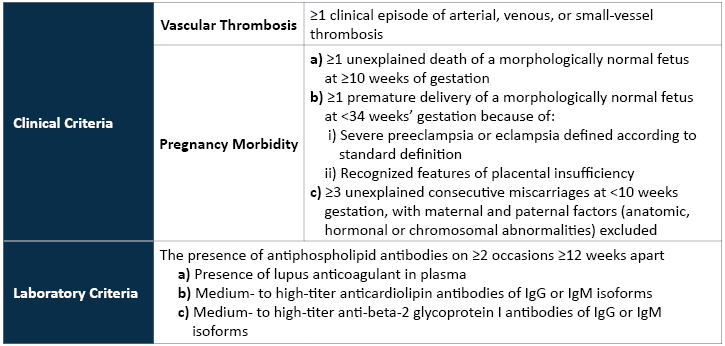APS 101 takes you through the ins and outs of APS, providing facts and key information to help you better understand the disease.
APS 101 is written by Jacqueline Madison, MD, Assistant Professor in the Division of Rheumatology and member of the Jason Knight Lab. In this month’s edition, Dr. Madison discusses APS classification criteria and what they mean.
APS Classification Criteria

What are the classification criteria for APS? And what even are classification criteria? How can they be useful or problematic?
When a doctor is trying to decide if a patient’s symptoms fit with a certain diagnosis, they often use something called classification criteria to help. Classification criteria are a list of symptoms and test results, often kind of like an equation, that we think patients with the diagnosis should fit. HOWEVER, the caveat is that classification criteria were developed with the purpose of finding patients with a certain disease for research studies. The criteria need to be pretty good at identifying the correct diagnosis so that researchers are studying the right people. They are NOT the exact same thing as diagnostic criteria; a doctor who is a specialist in a certain disease, like APS, can still diagnose a patient they think has that disease if they have a very strong reason why the patient might not fit the classification criteria. So, classification criteria are very helpful for making a diagnosis, but do not provide 100% certainty or set-in-stone rules all the time.
What are the classification criteria for APS? The classification criteria for APS are kind of like a recipe: you must have at least one lab and one clinical feature (one from each of the two main rows in the table below) to fit the classification for this disease. You can have more than one from each, but you cannot have only a positive lab test or only a clinical feature, such as a blood clot; both are needed.

There are 3 lab tests, and one of them must be positive to fit the criteria. These tests look for antiphospholipid antibodies in different ways. The tricky part to this half of the equation is that we and other researchers have found some other antiphospholipid antibodies that are not part of this equation (not yet, anyway… stay tuned!). The other important part of the lab criteria is that the lab abnormalities need to be durable, meaning that they are still positive if you were to check them about 3 months (technically 12 weeks) later. There are some scenarios in which one of these tests will be positive very briefly (for example in a severe infection), but then go away and seemingly not cause any problems. The criteria also define the exact results that make us say a test is positive.
The clinical portion of the criteria come in 2 categories: thrombosis (clotting) or pregnancy-related problems (called morbidity). Multiple different types of clotting are included: clots in the venous circulation (like a DVT of the leg), clots in the arterial circulation (like a stroke), or small vessel clots (like in the tiny blood vessels in the kidneys). For pregnancy-related APS, there are several ways to fit the criteria: recurrent early pregnancy loss (3 or more miscarriages prior to 10 weeks gestation) with no other cause, one later pregnancy loss (after 10 weeks gestation) with no identified abnormality of the fetus, or premature birth (before 34 weeks) due to eclampsia, severe pre-eclampsia, or placental insufficiency. Any one of these scenarios fits the clinical half of the criteria. The tricky part is that we frequently see other clinical symptoms with APS, too.
Overall, these classification criteria help doctors diagnose many cases of APS, although there are special cases that may or may not fit the criteria and require an APS specialist for diagnosis.
Contributed by Jacqueline Madison, MD
Reference:
Miyakis S, Lockshin MD, Atsumi T, Branch DW, Brey RL, Cervera R, et al. International consensus statement on an update of the classification criteria for definite antiphospholipid syndrome (APS). J Thromb Haemost 2006; 4: 295-306.
Join Our Email List
If you are interested in receiving updates on our patient care and research efforts, please join our APS Program email list.



